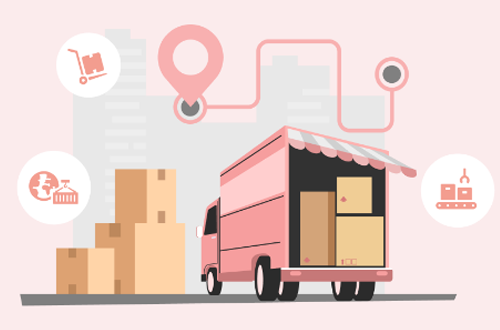Difference Between Traditional Logistics and E-Commerce Logistics
When the trend of cross-border e-commerce logistics industry sweeps across, as the number of traditional bulk goods decreases and the number of e-commerce transactions increases, there is a greater difference between traditional logistics and cross-border e-commerce logistics. For different business needs, How should companies choose and differentiate logistics?
The differences between traditional logistics and cross-border e-commerce logistics
Traditional logistics mainly provides a series of services for domestic manufacturing factories, domestic industries and manufacturers. It refers to the transportation and distribution of goods in traditional international trade. It mainly deals with large-volume, single category, fixed customer orders, transportation and payment collection. The cycle is long, and the objects and demands of logistics services are relatively stable. Point-to-point and line-to-line services are usually adopted, and the main modes of transportation are air and sea freight. This integrated logistics framework ensures seamless transportation of goods from origin to destination, contributing to the efficient functioning of domestic industrial supply chains.
Cross-border e-commerce logistics is mainly tailored to the needs of international trade and foreign e-commerce sellers, providing a complete set of services covering the entire logistics range. The main feature of cross-border e-commerce logistics is door-to-door service, that is, the logistics provider is responsible for the full service from the seller's pickup to delivery to the buyer's doorstep.
E-commerce logistics is the transportation and distribution of goods in cross-border retail trade based on network platforms. It mainly deals with orders from small batches, multiple categories, and scattered customers, and the transportation and payment cycle is short. This comprehensive support includes transportation, customs clearance, warehousing and end-to-end delivery services, ensuring a seamless journey for goods from origin to final destination.

The characteristic of cross-border e-commerce logistics is that it is committed to providing full-link services, covering all aspects of the logistics chain. In addition, the logistics framework integrates multimodal transportation, providing air, sea, commercial express, postal and other transportation options to facilitate global trade. This versatility ensures that sellers can choose the most appropriate and cost-effective shipping method based on their specific needs and the nature of the goods being transported. The integration of multiple transportation modes enhances flexibility and can be tailored to meet the unique requirements of cross-border e-commerce logistics.
This involves managing complex shipping, handling customs processes, overseeing warehousing and coordinating final deliveries. The goal is to simplify the entire logistics process for foreign e-commerce sellers, optimize efficiency and improve customer satisfaction.
traditional logistics and cross-border e-commerce logistics
Advantages of traditional logistics
Asset-light, flexible service, quick turnaround, and earn the price difference through personalized services. There is a mature international logistics system and standardized operating procedures, so the risks are low.
Disadvantages of traditional logistics
The traditional logistics model is usually unable to match cargo displacement information immediately, especially the information of scattered customers, and lacks differentiated and personalized service functions. Therefore, it can only provide centralized batch distribution and undifferentiated services. Poor adaptability and difficulty responding to market changes and the diverse needs of customers.
Advantages of cross-border e-commerce logistics
The capital turnover efficiency is high. Customers pay first for the purchase, and the seller delivers the goods by air. The transportation time is fast and the payment is returned quickly. With a high degree of informatization, it can carry out the flow of goods according to the individual needs of customers, monitor and track the status of goods in real time, not only achieve the lowest transportation cost through consolidation, but also rely on differentiated and personalized service delivery to improve the quality of logistics services.
At the same time, cross-border e-commerce logistics is highly adaptable and can adjust logistics products and channels according to market changes and customer needs.
Disadvantages of cross-border e-commerce logistics
Most of them are heavy assets and need to be equipped with warehouses and various types of equipment, develop and maintain logistics systems, and invest human and financial resources in marketing and publicity. In addition, there are many links, long chains, many details, and high risks. It is necessary to understand various overseas customs and government policies and last-mile channel rules, and to deal with various emergencies.
What are the operating models of cross-border e-commerce logistics?
Postal parcel mode: including China Post small parcel, China Post large parcel, etc., with high coverage and relatively cheap price.
Commercial express delivery model: including international express delivery (such as UPS, FedEx, DHL, TNT, etc.) and domestic express delivery. Commercial express delivery has powerful IT systems and localized services all over the world. It is the fastest among all logistics methods in terms of timeliness, but it is also the highest cost.
Supply chain service model: Logistics service supply chain is a new supply chain with integrated logistics service providers as the core enterprise (such as chinadivision), relying on information technology, guaranteed by funds and contracts, and through system design, process optimization, and collaborative operation , value-added services, information support and other methods to organically integrate and operate various logistics resources efficiently is a new organizational method.
Dedicated line logistics model: generally used for large goods and batch goods. The advantage is that it is convenient for one-time transportation of large goods and the freight is relatively cheap (such as shopv).
Overseas warehousing model: refers to the seller establishing a warehouse at the overseas sales destination. Once an order is placed, the goods can be shipped directly from the overseas warehouse. This model can save the cost of transportation from domestic to foreign countries and improve distribution efficiency.
In addition, there are FBA first-leg direct shipping, FBA transshipment modes, etc. FBA first-leg direct shipping refers to shipping goods directly from China to the Amazon warehouse. You can choose between direct express delivery and direct air freight. The FBA transshipment model refers to shipping goods from domestic to overseas warehouses and then delivering them from overseas warehouses.





